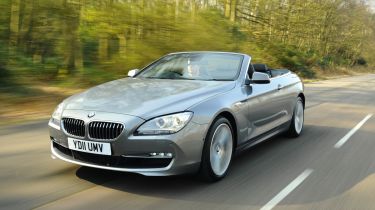BMW 640i SE Convertible
BMW's Six-cylinder newcomer scores big on style but trails on power compared to it's British rival
When the 6-Series was reborn in 2004, it certainly got people talking. Following in the tracks of the controversial 7-Series, BMW’s big coupé appeared awkward from many angles, with bumps and bulges where class rivals had curves and angles.
While we all eventually became used to the old-shape model’s styling in hard and soft-top guises, it’s clear BMW wanted us to fall for the charms of its 2011 6-Series more quickly. The new variant is sleeker, smoother and altogether more conservative than its predecessor, and resembles a US cruiser rather than a challenging trendsetter.
The most striking feature is its size. Not only is the new car a substantial 74mm longer and 39mm wider than the previous model, it also has a 9mm lower stance. This drop in height only serves to accentuate the car’s slabby proportions, leading to the low-rider look of a boulevard cabriolet.
The extra length is obvious on the inside as well, where the BMW is comfortably bigger than its competitor. The rear seats can accommodate adults at a squeeze, which isn’t something you can even contemplate in the Jaguar. However, don’t go thinking for a second that the 6-Series isn’t a serious driver’s car, too.
Used - available now

2021 Land Rover
Range Rover
27,750 milesAutomaticDiesel3.0L
Cash £49,995
2022 BMW
3 Series Touring
52,456 milesAutomaticDiesel2.0L
Cash £23,800
2018 Mazda
6 Saloon
48,985 milesAutomaticPetrol2.0L
Cash £12,600
2023 Mercedes
EQC
55,207 milesAutomaticElectric
Cash £22,300The new Convertible has the full force of BMW’s engineering expertise behind it, and comes initially in six-cylinder 640i or flagship V8 650i forms. The 3.0-litre straight-six we test delivers 316bhp and 450Nm of torque thanks to its TwinPower Turbo forced induction.
That punch comes consistently from as low as 1,300rpm and all the way to 4,500rpm, with a standard-fit eight-speed auto box making light work of keeping it in that peak torque band.
As a result, the BMW isn’t as far behind its V8-powered rival as you might expect. The 640i takes only three-tenths longer to cover 0-60mph, with a time of 5.5 seconds, and in-gear thrust is also relatively even. However, the British model often feels faster because of its sensitive accelerator pedal.
The 640i provides a raft of baffling adjustments if you opt for the £3,400 Adaptive Drive system. This offers Comfort, Normal, Sport and Sport+ modes, which gradually transform the cabriolet from comfortable cruiser into hardcore driving machine by adjusting suspension settings, throttle and steering responses, plus gearbox set-up. The technology also allows more wheel slip by reining in the stability control.
Turn into a corner in the most advanced setting, and the total lack of body roll sets the BMW apart. Plus, with greater grip and feel through the steering wheel, the car seems more sure-footed, while the £1,220 optional Integral Active Steering package helps drivers attack corners with ease by turning both the front and rear wheels. What’s more, the BMW is 50 per cent stiffer than its predecessor, making for very little shake or rattle – even when you hit mid-corner bumps.
In everyday situations, the 640i is no more challenging to drive than the maker’s 5-Series executive car, every bit as smooth over potholes as the XK and much easier to place on the road. Buffeting is kept to a minimum with the hood down, and with it in place, the superior sound insulation makes the BMW quieter on the move than the Jaguar – although the top takes longer to complete its folding gymnastics.
Sat behind the wheel in everyday traffic, drivers will also appreciate the 6-Series’ superb cabin. Complementing the usual BMW style is attractive leather-upholstered trim and superb ergonomics. Plus, the genuine four-seater layout and 350-litre luggage bay make it surprisingly practical – which is more than can be said for the Jaguar...
Details
Chart position: 1
WHY: All-new 6-Series is a technological tour de force. Entry-level straight-six engine promises strong performance and economy, but can it challenge its V8 rival?







